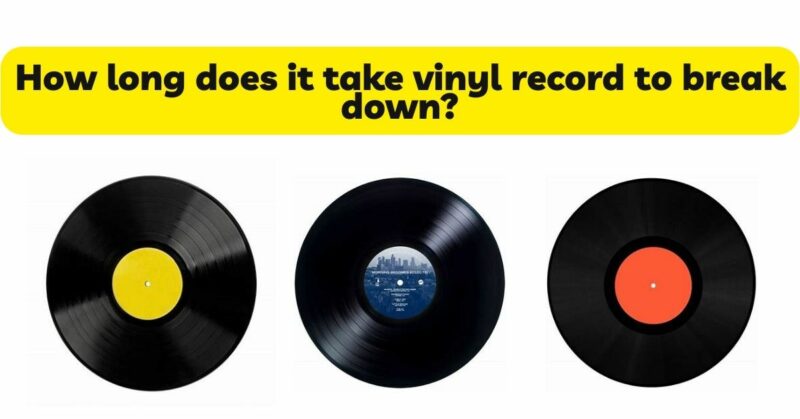Vinyl records have been cherished by music enthusiasts for decades, offering a unique listening experience and a tangible connection to the past. However, like any material, vinyl records are subject to degradation over time. The degradation process can vary based on several factors, including environmental conditions, handling, and storage practices. In this article, we will explore the factors that contribute to vinyl record breakdown and discuss the estimated timeframe for degradation to help vinyl enthusiasts understand how to preserve their collections effectively.
Understanding Vinyl Record Composition:
To comprehend the degradation process, it is crucial to understand the composition of vinyl records. Vinyl records are made primarily of polyvinyl chloride (PVC), a durable and flexible plastic material. PVC is blended with various additives, such as stabilizers and lubricants, to enhance its properties and make it suitable for recording and playing music. The vinyl disc is then coated with a protective layer to guard against scratches and damage.
Factors Affecting Vinyl Record Degradation:
- Environmental Conditions: Environmental factors significantly influence the degradation of vinyl records. Exposure to extreme temperatures, high humidity, direct sunlight, and fluctuating climate conditions can accelerate the breakdown process. These conditions can cause warping, discoloration, mold growth, and deterioration of the vinyl material over time.
- Handling and Storage: Improper handling and storage practices can contribute to the degradation of vinyl records. Rough handling, excessive touching of the record surface, and improper cleaning techniques can result in scratches, scuffs, and surface damage. Inadequate storage conditions, such as stacking records improperly or subjecting them to excessive pressure, can lead to warping, groove distortion, and other forms of structural damage.
- Play Frequency: The frequency of playing vinyl records can also impact their degradation. Each play exerts friction and pressure on the record surface, which can lead to wear and tear over time. While vinyl records are designed to withstand multiple plays, excessive and careless handling can accelerate their breakdown.
Estimated Timeframe for Vinyl Record Degradation:
It is challenging to provide an exact timeframe for vinyl record degradation, as it depends on various factors, including the quality of the vinyl, storage conditions, and handling practices. However, certain estimations can give us a general understanding of the potential lifespan of vinyl records.
- Structural Integrity: Under optimal conditions, vinyl records can maintain their structural integrity for several decades. Proper storage in a controlled environment with stable temperature and humidity, along with careful handling and maintenance, can help extend the lifespan of records. However, without proper care, records may start to exhibit signs of wear, warping, and groove distortion within 10 to 20 years.
- Sound Quality: The sound quality of vinyl records can degrade over time due to wear on the grooves and the buildup of dirt and debris. With frequent plays and inadequate cleaning, sound quality may diminish after approximately 500 plays. However, this estimation can vary significantly based on factors such as stylus quality, cleaning practices, and the overall condition of the record.
Preserving Vinyl Records:
To preserve vinyl records and prolong their lifespan, consider the following practices:
- Proper Storage: Store vinyl records in a controlled environment with stable temperature (around 50°F to 70°F or 10°C to 21°C) and humidity (around 40% to 50%). Avoid exposure to direct sunlight, extreme temperatures, and high humidity levels. Store records vertically in sturdy, acid-free sleeves and protective outer covers to minimize the risk of warping, scratches, and dust buildup.
- Gentle Handling: Handle vinyl records with care to avoid surface damage. Hold records by their edges or the center label to prevent fingerprints and smudges. Use a carbon fiber brush or an anti-static record cleaning brush to remove dust particles before and after each play. Avoid using abrasive cleaning materials or excessive pressure during cleaning.
- Proper Playback Equipment: Invest in high-quality turntables, cartridges, and styli to ensure gentle and accurate playback. A worn or damaged stylus can cause additional wear on the record grooves, diminishing sound quality and shortening the record’s lifespan.
- Regular Maintenance: Implement a regular cleaning routine to remove dust and debris from vinyl records. Clean the stylus regularly to prevent buildup and ensure optimal sound quality. Inspect records periodically for signs of damage or wear, addressing any issues promptly to prevent further degradation.
Conclusion:
Vinyl records, like any material, are subject to degradation over time. The lifespan of a vinyl record depends on various factors, including environmental conditions, handling practices, and storage methods. While it is challenging to provide an exact timeframe for vinyl record degradation, proper care, storage, and maintenance can help extend their lifespan and preserve their sound quality. By creating a controlled storage environment, practicing gentle handling, using high-quality playback equipment, and implementing regular maintenance routines, vinyl enthusiasts can enjoy their collections for many years to come, ensuring the preservation of both the music and the cultural heritage that vinyl records represent.


